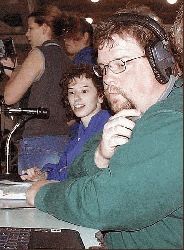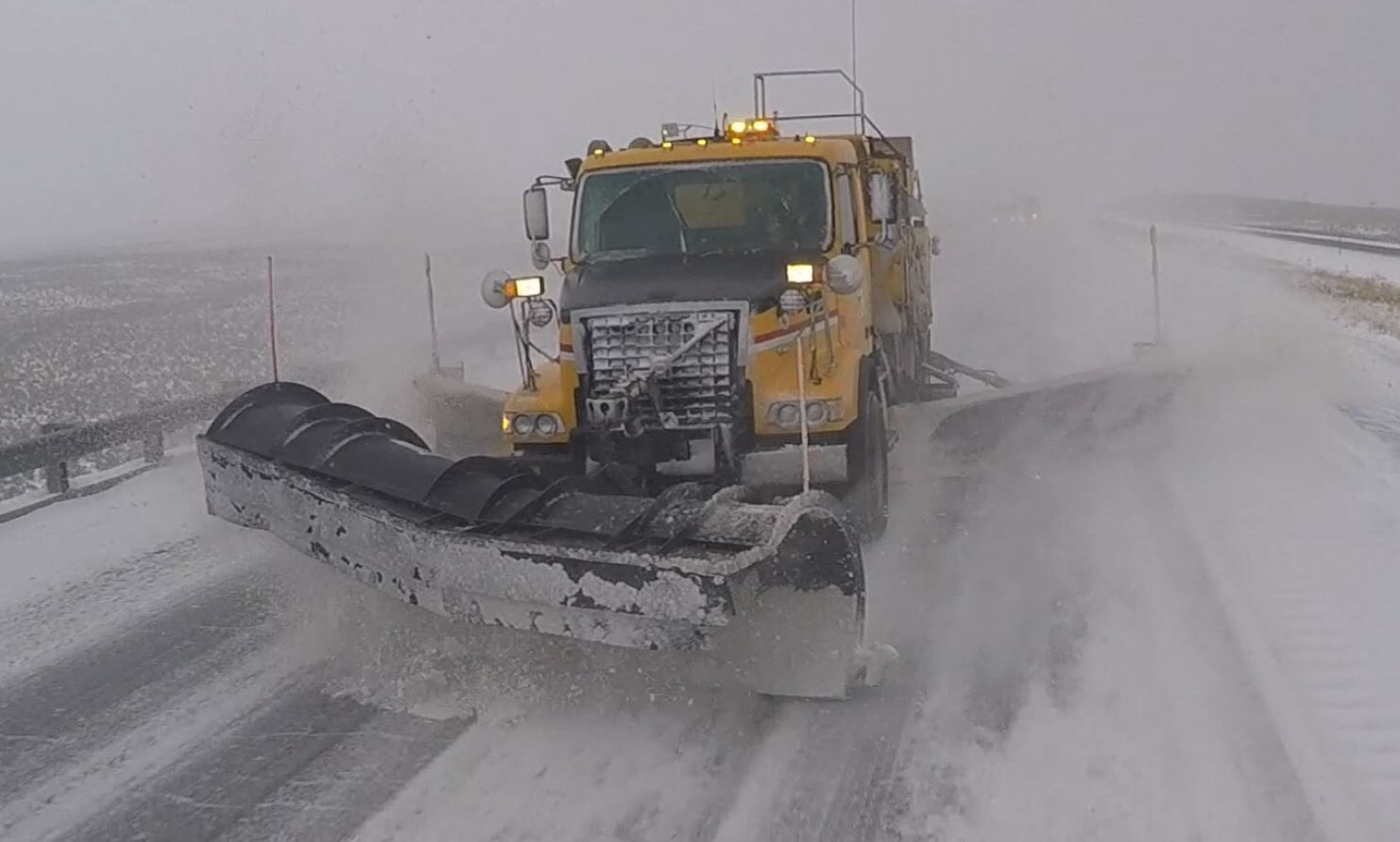Broadcast live in HonkerVision
Published 12:00 am Thursday, March 6, 2003

- Mark Rouska, right, and Tiffany Booth wait to "go hot'' for their live broadcast of Arlington's state basketball game against McKenzie. In the background, Tiffany Rushing, gray vest, and Michelle Barry prepare to record the game by video camera. (Baker City Herald/S. John Collins).
By LISA BRITTON
Trending
Of the Baker City Herald
Clad in blue and gold tie-dye, Allan Cunningham hovers behind a table strewn with cables in the upper level of the Baker High School gymnasium making last-minute adjustments.
Every so often he stretches his fingers, then glances at his cell phone in anticipation of problems.
Trending
andquot;We’ll go hot in 10,andquot; he says to the three seated at the table one manning a computer and the other two sitting at microphones.
Cunningham brought a crew of four to the Class 1A state basketball tournament to pull off something they’ve never done a live audio broadcast of the Arlington Honker’s game on the 50-student school’s local cable television station.
andquot;We’ve never done a remote. We’ve always done it live from our gym,andquot; he said before Wednesday afternoon’s game, Arlington’s first appearance in the state tournament since 1986.
Watching Honker home games is second-nature to folks in Arlington, population 530. Games are aired live on HonkerVision, a nonprofit co-op television station run by Arlington High School students in the HonkerTech class.
The HonkerTech crew couldn’t air the state game live on video due to problems with bandwidth, but those stuck back home received the next best thing play-by-play commentary broadcast over the TV station, with still pictures of Honker games at the district tournament as visuals.
Cunningham said they had an extra telephone line wired into the southeast corner of the BHS gymnasium so they wouldn’t interfere with other broadcasts.
andquot;We had a new line put in so we don’t step on anybody’s toes,andquot; he said.
Then they borrowed a telephone box from local radio station KCMB. With five minutes on the clock before the Honkers tipped off against the McKenzie Eagles, he called the school in Arlington, where local andquot;cable guyandquot; Mark Stewart was waiting.
Stewart then called back to hook up the connection.
Due to technical problems, the audio relay system had to be modified Stewart transferred the live broadcast to speaker phone, then pushed a microphone right up to the speaker, hooking the sound into the television station.
Then Cunningham received the phone call he yearned for Stewart’s assurance that everything sounded fine.
Arlington student teacher Mark Rouska was andquot;the voice of the Honkers,andquot; joined with color commentary from senior Tiffany Booth.
This was the first live no-picture audio either have attempted.
andquot;When you’re doing it live on TV and the game’s kind of boring, you can sit back and let the game speak for itself,andquot; Rouska said.
To prepare for continuous commentary during the basketball game, Rouska practiced on his family, documenting every move they made for the past week with descriptors and exclamations.
andquot;It made my family nervous because everywhere they went, I knew what they were doing,andquot; he said.
Arlington junior Jason Rucker is the producer and engineer in his third year with HonkerTech. On Wednesday he was in charge of airing the sponsor andquot;spotsandquot; designated by the Oregon Schools Activities Association and Oregon Association of Broadcasters. Though it was his first experience with radio, he’d completed similar tasks with HonkerVision.
andquot;Back at home we do sound effects and music we add in every once in a while it’s kind of the same thing,andquot; he said.
It was making time for the spots he worried about.
andquot;Especially with him,andquot; Rucker grinned and pointed to Rouska. andquot;It’s hard to get a word in edgewise.andquot;
Tiffany Rushing, camera operator, and Michelle Barry, Cunningham’s andquot;executive assistant,andquot; took turns with the video camera, capturing the game on tape and a nearby television screen. Wednesday’s game will be shown on HonkerVision sometime next week, Cunningham said.
andquot;We’ll figure out when people want to watch it,andquot; he said.
For the past seven years, students at Arlington High School have run HonkerVision and HonkerNet. Both are under the title of HonkerTech, a class that involves web design, video production, advertising and more.
Along with his duties as science, art and shop teacher, coordinating long distance learning and coaching track, Cunningham is the andquot;CEO and executive directorandquot; of HonkerTech.
andquot;Nothing really happens with the system without me knowing it,andquot; he said.
The student-run station HonkerVision is Channel 14 in Arlington.
andquot;Some people have cable just for HonkerVision,andquot; Cunningham said.
The idea for a television station emerged as the students became more involved with technology.
andquot;We’d make films instead of do tests,andquot; he said.
Now the station is set up to broadcast the home Honker games live, with multiple cameras positioned around the gym.
They also air the occasional Christmas program.
In addition to television, the HonkerTech students work with Internet technology.
The tech class, which has anywhere from two to seven students each year, set up HonkerNet as the school’s Web site, as well as local Internet dial-up access.
With this, they provide Internet access to 85 customers in Arlington, Cunningham said.
andquot;The students have total control over the school’s Web site,andquot; he said.
With that comes responsibility. HonkerNet has more than 450 web pages the students constantly monitor and work on.
andquot;The class takes a lot of ownership over what they do,andquot; Cunningham said.
The Internet access and paid advertisements for the television station and Web site also provide a cash flow for HonkerTech.
andquot;It’s a student-run business that makes money for the technology and scholarships. Between the dial-ups and TV station, we’ve put $11,000 into scholarships in the last four years,andquot; Cunningham said.
HonkerVision scholarships are for anyone who graduates from AHS up to four years after graduation. These are usually $200 to $300 each.
HonkerNet scholarships are designated 40 percent of net sales from the technology business, and are available to students in the their second year of higher education.
andquot;That promotes longevity in college,andquot; Cunningham said.
These scholarships are compensation for the time HonkerTech students spend working on the television station, Internet web pages or home technology visits.
This works out to about $3 to $4.50 per hour.
andquot;You can’t pay the kids with cash in their pockets you give them scholarships and buy them toys,andquot; Cunningham said.
The andquot;toysandquot; include six portable wireless computers, digital cameras, video cameras and more, all purchased with the income from the station and Web site.
andquot;Stuff we need that we’d normally have to beg the school board for,andquot; Cunningham said.
All this technology comes in handy when the basketball team qualifies for state.
As soon as Cunningham learns everything is operating smoothly with the broadcast, he settles back to watch the game. When he turns, a faint andquot;Aandquot; shows in his hair, something he shaved in the back of his head three weeks ago.
He cheers and claps with the Arlington fans, then scrutinizes the game on the television screen.
andquot;Follow the ball, follow ball,andquot; he mutters as the Honkers shoot.
Then he smiles.
andquot;I’m talking to the camera operators. The players have enough people yelling at them.andquot;









